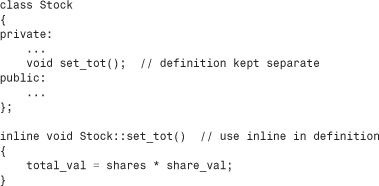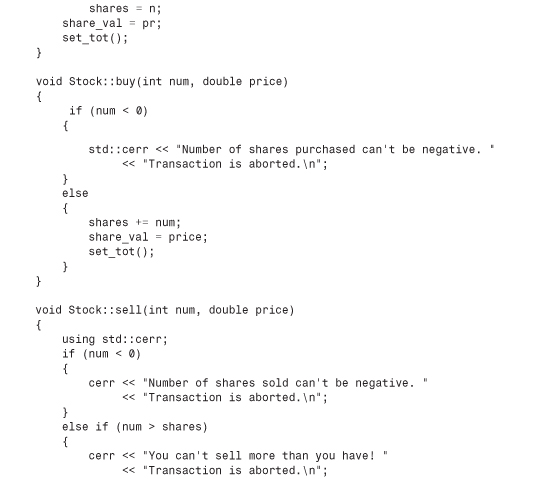Chapter 10. Objects and Classes
In this chapter you’ll learn about the following:
• Procedural and object-oriented programming
• The concept of classes
• How to define and implement a class
• Public and private class access
• Class data members
• Class methods (also called class function members)
• Creating and using class objects
• Class constructors and destructors
• Creating arrays of objects
Object-oriented programming (OOP) is a particular conceptual approach to designing programs, and C++ has enhanced C with features that ease the way to applying that approach. The following are the most important OOP features:
• Abstraction
• Encapsulation and data hiding
• Polymorphism
• Inheritance
• Reusability of code
The class is the single most important C++ enhancement for implementing these features and tying them together. This chapter begins an examination of classes. It explains abstraction, encapsulation, and data hiding, and shows how classes implement these features. It discusses how to define a class, provide a class with public and private sections, and create member functions that work with the class data. Also, this chapter acquaints you with constructors and destructors, which are special member functions for creating and disposing of objects that belong to a class. Finally, you’ll meet the this pointer, an important component of some class programming. The following chapters extend this discussion to operator overloading (another variety of polymorphism) and inheritance, the basis for reusing code.
Procedural and Object-Oriented Programming
Although in this book we have occasionally explored the OOP perspective on programming, we’ve usually stuck pretty close to the standard procedural approach of languages such as C, Pascal, and BASIC. Let’s look at an example that clarifies how the OOP outlook differs from that of procedural programming.
As the newest member of the Genre Giants softball team, you’ve been asked to keep the team statistics. Naturally, you turn to your computer for help. If you were a procedural programmer, you might think along these lines:
Let’s see, I want to enter the name, times at bat, number of hits, batting averages (for those who don’t follow baseball or softball, the batting average is the number of hits divided by the player’s official number of times at bat; an at bat terminates when a player gets on base or makes an out, but certain events, such as getting a walk, don’t count as official times at bat), and all those other great basic statistics for each player. Wait, the computer is supposed to make life easier for me, so I want to have it figure out some of that stuff, such as the batting average. Also, I want the program to report the results. How should I organize this? I guess I should do things right and use functions. Yeah, I’ll make main() call a function to get the input, call another function to make the calculations, and then call a third function to report the results. Hmmm, what happens when I get data from the next game? I don’t want to start from scratch again. Okay, I can add a function to update the statistics. Golly, maybe I’ll need a menu in main() to select between entering, calculating, updating, and showing the data. Hmmm...how am I going to represent the data? I could use an array of strings to hold the players’ names, another array to hold the at bats for each player, yet another array to hold the hits, and so on. No, that’s dumb. I can design a structure to hold all the information for a single player and then use an array of those structures to represent the whole team.
In short, with a procedural approach, you first concentrate on the procedures you will follow and then think about how to represent the data. (Note: So that you don’t have to keep the program running the whole season, you probably also want to be able to save data to a file and read data from a file.)
Now let’s see how your perspective changes when you don your OOP hat (in an attractive polymorphic design). You begin by thinking about the data. Furthermore, you think about the data not only in terms of how to represent it but in terms of how it’s to be used:
Let’s see, what am I keeping track of? A ball player, of course. So, I want an object that represents the whole player, not just her batting average or times at bat. Yeah, that’ll be my fundamental data unit, an object representing the name and statistics for a player. I’ll need some methods to handle this object. Hmmm, I guess I need a method to get basic information into this unit. The computer should calculate some of the stuff, like the batting averages—I can add methods to do calculations. And the program should do those calculations automatically, without the user having to remember to ask to have them done. Also, I’ll need methods for updating and displaying the information. So the user gets three ways to interact with the data: initialization, updating, and reporting. That’s the user interface.
In short, with an OOP approach, you concentrate on the object as the user perceives it, thinking about the data you need to describe the object and the operations that will describe the user’s interaction with the data. After you develop a description of that interface, you move on to decide how to implement the interface and data storage. Finally, you put together a program to use your new design.
Abstraction and Classes
Life is full of complexities, and one way we cope with complexity is to frame simplifying abstractions. You are a collection of more than an octillion atoms. Some students of the mind would say that your mind is a collection of semiautonomous agents. But it’s much simpler to think of yourself as a single entity. In computing, abstraction is the crucial step of representing information in terms of its interface with the user. That is, you abstract the essential operational features of a problem and express a solution in those terms. In the softball statistics example, the interface describes how the user initializes, updates, and displays the data. From abstraction, it is a short step to the user-defined type, which in C++ is a class design that implements the abstract interface.
What Is a Type?
Let’s think a little more about what constitutes a type. For example, what is a nerd? If you subscribe to the popular stereotype, you might think of a nerd in visual terms—thick, black-rimmed glasses, pocket protector full of pens, and so on. After a little reflection, you might conclude that a nerd is better defined operationally—for example, in terms of how he or she responds to an awkward social situation. You have a similar situation, if you don’t mind stretched analogies, with a procedural language such as C. At first, you tend to think of a data type in terms of its appearance—how it is stored in memory. A char, for example, is 1 byte of memory, and a double is often 8 bytes of memory. But a little reflection leads you to conclude that a data type is also defined in terms of the operations that can be performed on it. For example, the int type can use all the arithmetic operations. You can add, subtract, multiply, and divide integers. You can also use the modulus operator (%) with them.
On the other hand, consider pointers. A pointer might very well require the same amount of memory as an int. It might even be represented internally as an integer. But a pointer doesn’t allow the same operations that an integer does. You can’t, for example, multiply two pointers by each other. The concept makes no sense, so C++ doesn’t implement it. Thus, when you declare a variable as an int or as a pointer-to-float, you’re not just allocating memory—you are also establishing which operations can be performed with the variable. In short, specifying a basic type does three things:
• It determines how much memory is needed for a data object.
• It determines how the bits in memory are interpreted. (A long and a float might use the same number of bits in memory, but they are translated into numeric values differently.)
• It determines what operations, or methods, can be performed using the data object.
For built-in types, the information about operations is built in to the compiler. But when you define a user-defined type in C++, you have to provide the same kind of information yourself. In exchange for this extra work, you gain the power and flexibility to custom fit new data types to match real-world requirements.
Classes in C++
A class is a C++ vehicle for translating an abstraction to a user-defined type. It combines data representation and methods for manipulating that data into one neat package. Let’s look at a class that represents stocks.
First, you have to think a bit about how to represent stocks. You could take one share of stock as the basic unit and define a class to represent a share. However, that implies that you would need 100 objects to represent 100 shares, and that’s not practical. Instead, you can represent a person’s current holdings in a particular stock as a basic unit. The number of shares owned would be part of the data representation. A realistic approach would have to maintain records of such things as initial purchase price and date of purchase, for tax purposes. Also, it would have to manage events such as stock splits. That seems a bit ambitious for your first effort at defining a class, so you can instead take an idealized, simplified view of matters. In particular, you should limit the operations you can perform to the following:
• Acquire stock in a company.
• Buy more shares of the same stock.
• Sell stock.
• Update the per-share value of a stock.
• Display information about the holdings.
You can use this list to define the public interface for the stock class. (And you can add additional features later if you’re interested.) To support this interface, you need to store some information. Again, you can use a simplified approach. For example, you shouldn’t worry about the U.S. practice of evaluating stocks in multiples of eighths of a dollar. (Apparently the New York Stock Exchange must have seen this simplification in a previous edition of the book because it has decided to change over to the system used here.) You should store the following information:
• Name of company
• Number of stocks owned
• Value of each share
• Total value of all shares
Next, you can define the class. Generally, a class specification has two parts:
• A class declaration, which describes the data component, in terms of data members, and the public interface, in terms of member functions, termed methods
• The class method definitions, which describe how certain class member functions are implemented
Roughly speaking, the class declaration provides a class overview, whereas the method definitions supply the details.
Developing a class and a program using it requires several steps. Rather than take them all at once, let’s break up the development into smaller stages; later the code for these stages is merged together into Listing 10.3. Listing 10.1 presents the first stage, a tentative class declaration for a class called Stock. (To help identify classes, this book follows a common, but not universal, convention of capitalizing class names.) You’ll notice that Listing 10.1 looks like a structure declaration with a few additional wrinkles, such as member functions and public and private sections. You’ll improve on this declaration shortly (so don’t use it as a model), but first let’s see how this definition works.
Listing 10.1. The First Part of stocks.cpp
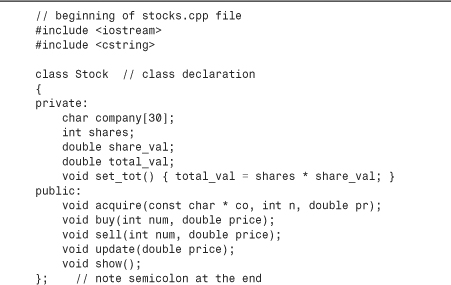
You’ll get a closer look at the class details later, but first let’s examine the more general features. To begin, the C++ keyword class identifies the code in Listing 10.1 as defining the design of a class. The syntax identifies Stock as the type name for this new class. This declaration enables you to declare variables, called objects, or instances, of the Stock type. Each individual object represents a single holding. For example, the declarations
Stock sally;
Stock solly;
create two Stock objects called sally and solly. The sally object, for example, could represent Sally’s stock holdings in a particular company.
Next, notice that the information you decided to store appears in the form of class data members, such as company and shares. The company member of sally, for example, holds the name of the company, the share member holds the number of shares Sally owns, the share_val member holds the value of each share, and the total_val member holds the total value of all the shares. Similarly, the operations you want appear as class function members (or methods), such as sell() and update(). A member function can be defined in place—for example, set_tot()—or it can be represented by a prototype, like the other member functions in this class. The full definitions for the other member functions come later, but the prototypes suffice to describe the function interfaces. The binding of data and methods into a single unit is the most striking feature of the class. Because of this design, creating a Stock object automatically establishes the rules governing how that object can be used.
You’ve already seen how the istream and ostream classes have member functions, such as get() and getline(). The function prototypes in the Stock class declaration demonstrate how member functions are established. The iostream header file, for example, has a getline() prototype in the istream class declaration.
Also new are the keywords private and public. These labels describe access control for class members. Any program that uses an object of a particular class can access the public portions directly. A program can access the private members of an object only by using the public member functions (or, as you’ll see in Chapter 11, “Working with Classes,” via a friend function). For example, the only way to alter the shares member of the Stock class is to use one of the Stock member functions. Thus, the public member functions act as go-betweens between a program and an object’s private members; they provide the interface between object and program. This insulation of data from direct access by a program is called data hiding. (C++ provides a third access-control keyword, protected, which we’ll discuss when we cover class inheritance in Chapter 13, “Class Inheritance.”) (See Figure 10.1.) Whereas data hiding may be an unscrupulous act in, say, a stock fund prospectus, it’s a good practice in computing because it preserves the integrity of the data.
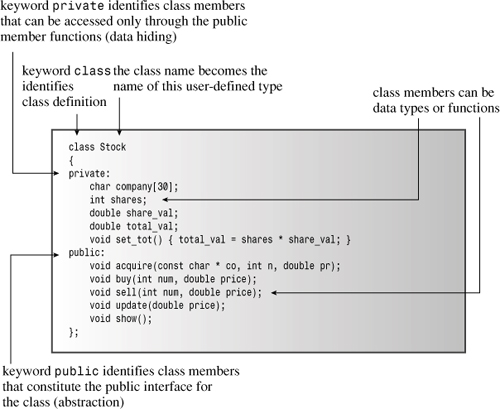
A class design attempts to separate the public interface from the specifics of the implementation. The public interface represents the abstraction component of the design. Gathering the implementation details together and separating them from the abstraction is called encapsulation. Data hiding (putting data into the private section of a class) is an instance of encapsulation, and so is hiding functional details of an implementation in the private section, as the Stock class does with set_tot(). Another example of encapsulation is the usual practice of placing class function definitions in a separate file from the class declaration.
Note that data hiding not only prevents you from accessing data directly, but it also absolves you (in the roll as a user of the class) from needing to know how the data is represented. For example, the show() member displays, among other things, the total value of a holding. This value can be stored as part of an object, as the code in Listing 10.1 does, or it can be calculated when needed. From the standpoint of the user, it makes no difference which approach is used. What you do need to know is what the different member functions accomplish; that is, you need to know what kinds of arguments a member function takes and what kind of return value it has. The principle is to separate the details of the implementation from the design of the interface. If you later find a better way to implement the data representation or the details of the member functions, you can change those details without changing the program interface, and that makes programs much easier to maintain.
Member Access Control: Public or Private?
You can declare class members, whether they are data items or member functions, either in the public or the private section of a class. But because one of the main precepts of OOP is to hide the data, data items normally go into the private section. The member functions that constitute the class interface go into the public section; otherwise, you can’t call those functions from a program. As the Stock declaration shows, you can also put member functions in the private section. You can’t call such functions directly from a program, but the public methods can use them. Typically, you use private member functions to handle implementation details that don’t form part of the public interface.
You don’t have to use the keyword private in class declarations because that is the default access control for class objects:
class World
{
float mass; // private by default
char name[20]; // private by default
public:
void tellall(void);
...
};
However, this book explicitly uses the private label in order to emphasize the concept of data hiding.
Implementing Class Member Functions
You still have to create the second part of the class specification: providing code for those member functions represented by a prototype in the class declaration. Member function definitions are much like regular function definitions. Each has a function header and a function body. Member function definitions can have return types and arguments. But they also have two special characteristics:
• When you define a member function, you use the scope-resolution operator (::) to identify the class to which the function belongs.
• Class methods can access the private components of the class.
Let’s look at these points now.
First, the function header for a member function uses the scope-resolution operator (::) to indicate to which class the function belongs. For example, the header for the update() member function looks like this:
void Stock::update(double price)
This notation means you are defining the update() function that is a member of the Stock class. Not only does this identify update() as a member function, it means you can use the same name for a member function for a different class. For example, an update() function for a Buffoon class would have this function header:
void Buffoon::update()
Thus, the scope-resolution operator resolves the identity of the class to which a method definition applies. We say that the identifier update() has class scope. Other member functions of the Stock class can, if necessary, use the update() method without using the scope-resolution operator. That’s because they belong to the same class, making update() in scope. Using update() outside the class declaration and method definitions, however, requires special measures, which we’ll get to soon.
One way of looking at method names is that the complete name of a class method includes the class name. Stock::update() is called the qualified name of the function. A simple update(), on the other hand, is an abbreviation (the unqualified name) for the full name—one that can be used just in class scope.
The second special characteristic of methods is that a method can access the private members of a class. For example, the show() method can use code like this:
cout << "Company: " << company
<< " Shares: " << shares << endl
<< " Share Price: $" << share_val
<< " Total Worth: $" << total_val << endl;
Here company, shares, and so on are private data members of the Stock class. If you try to use a nonmember function to access these data members, the compiler stops you cold in your tracks. (However, friend functions, which Chapter 11 discusses, provide an exception.)
With these two points in mind, you can implement the class methods as shown in Listing 10.2. These method definitions can go in a separate file or in the same file with the class declaration. Because you are beginning simply, you can assume that these definitions follow the class declaration in the same file. This is the easiest, although not the best, way to make the class declaration available to the method definitions. (The best way, which you’ll apply later in this chapter, is to use a header file for the class declaration and a separate source code file for the class member function definitions.) To provide more namespace experience, the code uses the std:: qualifier in some methods and using declarations in others.
Listing 10.2. stocks.cpp Continued
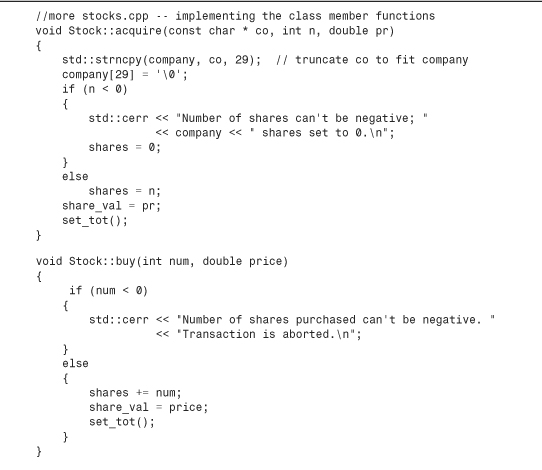
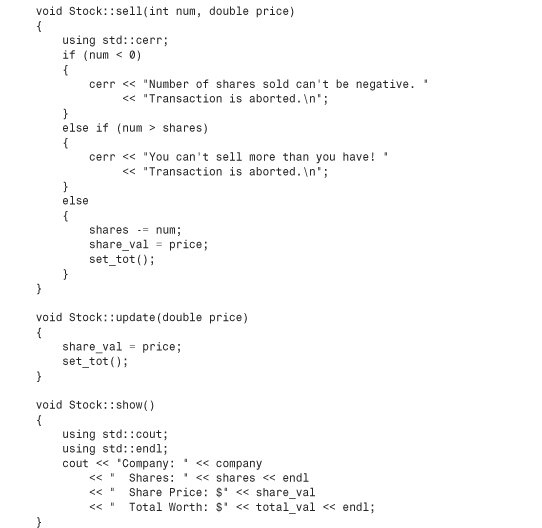
Member Function Notes
The acquire() function manages the first acquisition of stock for a given company, whereas buy() and sell() manage adding to or subtracting from an existing holding. The buy() and sell() methods make sure that the number of shares bought or sold is not a negative number. Also, if the user attempts to sell more shares than he or she has, the sell() function terminates the transaction. The technique of making the data private and limiting access to public functions gives you control over how the data can be used; in this case, it allows you to insert these safeguards against faulty transactions.
Four of the member functions set or reset the total_val member value. Rather than write this calculation four times, the class has each function call the set_tot() function. Because this function is merely the means of implementing the code and not part of the public interface, the class makes set_tot() a private member function. (That is, set_tot() is a member function used by the person writing the class but not used by someone writing code that uses the class.) If the calculation were lengthy, this could save some typing and code space. Here, however, the main value is that by using a function call instead of retyping the calculation each time, you ensure that exactly the same calculation gets done. Also, if you have to revise the calculation (which is not likely in this particular case), you have to revise it in just one location.
The acquire() method uses strncpy() to copy the string. In case you’ve forgotten, the call strncpy(s2, s1, n) copies s1 to s2 or else up to n characters from s1 to s2, whichever comes first. If s1 contains fewer characters than n, the strncpy() function pads s2 with null characters. That is, strncpy(firstname, "Tim", 6) copies the characters T, i, and m to firstname and then adds three null characters to bring the total to six characters. But if s1 is longer than n, no null characters are appended. That is, strncpy(firstname, "Priscilla", 4) just copies the characters P, r, i, and s to firstname, making it a character array but, because it lacks a terminating null character, not a string. Therefore, acquire() places a null character at the end of the array to guarantee that it is a string.
Inline Methods
Any function with a definition in the class declaration automatically becomes an inline function. Thus, Stock::set_tot() is an inline function. Class declarations often use inline functions for short member functions, and set_tot() qualifies on that account.
You can, if you like, define a member function outside the class declaration and still make it inline. To do so, you just use the inline qualifier when you define the function in the class implementation section:
The special rules for inline functions require that they be defined in each file in which they are used. The easiest way to make sure that inline definitions are available to all files in a multifile program is to include the inline definition in the same header file in which the corresponding class is defined. (Some development systems may have smart linkers that allow the inline definitions to go into a separate implementation file.)
Incidentally, according to the rewrite rule, defining a method in a class declaration is equivalent to replacing the method definition with a prototype and then rewriting the definition as an inline function immediately after the class declaration. That is, the original inline definition of set_tot() in Listing 10.2 is equivalent to the one just shown, with the definition following the class declaration.
Which Object Does a Method Use?
Now we come to one of the most important aspects of using objects: how you apply a class method to an object. Code such as
shares += num;
uses the shares member of an object. But which object? That’s an excellent question! To answer it, first consider how you create an object. The simplest way is to declare class variables:
Stock kate, joe;
This creates two objects of the Stock class, one named kate and one named joe.
Next, consider how to use a member function with one of these objects. The answer, as with structures and structure members, is to use the membership operator:
kate.show(); // the kate object calls the member function
joe.show(); // the joe object calls the member function
The first call here invokes show() as a member of the kate object. This means the method interprets shares as kate.shares and share_val as kate.share_val. Similarly, the call joe.show() makes the show() method interpret shares and share_val as joe.shares and joe.share_val, respectively.
Remember
![]()
When you call a member function, it uses the data members of the particular object used to invoke the member function.
Similarly, the function call kate.sell() invokes the set_tot() function as if it were kate.set_tot(), causing that function to get its data from the kate object.
Each new object you create contains storage for its own internal variables, the class members. But all objects of the same class share the same set of class methods, with just one copy of each method. Suppose, for example, that kate and joe are Stock objects. In that case, kate.shares occupies one chunk of memory and joe.shares occupies a second chunk of memory. But kate.show() and joe.show() both invoke the same method—that is, both execute the same block of code. They just apply the code to different data. Calling a member function is what some OOP languages term sending a message. Thus, sending the same message to two different objects invokes the same method but applies it to two different objects. (See Figure 10.2.)
Figure 10.2. Objects, data, and member functions.

Using Classes
In this chapter you’ve seen how to define a class and its class methods. The next step is to produce a program that creates and uses objects of a class. The C++ goal is to make using classes as similar as possible to using the basic, built-in types, such as int and char. You can create a class object by declaring a class variable or using new to allocate an object of a class type. You can pass objects as arguments, return them as function return values, and assign one object to another. C++ provides facilities for initializing objects, teaching cin and cout to recognize objects, and even providing automatic type conversions between objects of similar classes. It will be a while before you can do all those things, but let’s start now with the simpler properties. Indeed, you’ve already seen how to declare a class object and call a member function. Listing 10.3 combines those techniques with the class declaration and the member function definitions to form a complete program. It creates a Stock object named stock1. The program is simple, but it tests the features you have built in to the class.
Listing 10.3. The Full stocks.cpp Program

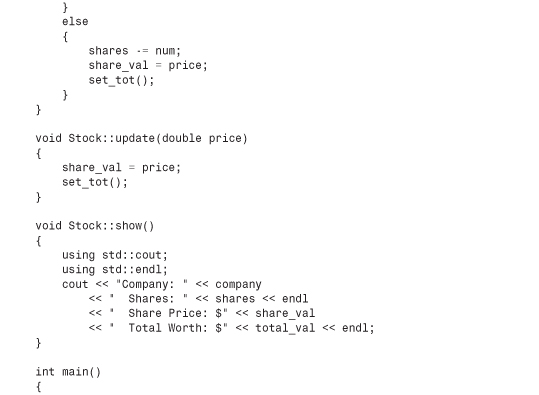
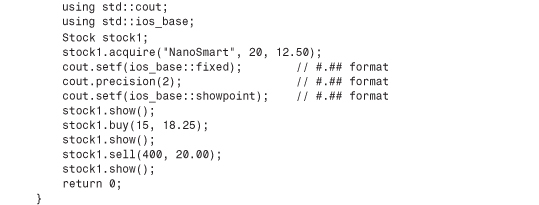
The program in Listing 10.3 uses three formatting commands:
![]()
It also has this using declaration:
using std::ios_base;
This is a case of nested namespaces. The fixed and showpoint identifiers are part of the ios_base namespace, and the ios_base namespace is part of the std namespace. The net effect of the formatting statements is to display two digits to the right of the decimal, including trailing zeros. Actually, only the first two are needed, according to current practices, and older C++ implementations just need the first and third. Using all three produces the same output for both newer and older implementations. See Chapter 17, “Input, Output, and Files,” for the details. Meanwhile, here is the output of the program in Listing 10.3:
Company: NanoSmart Shares: 20
Share Price: $12.50 Total Worth: $250.00
Company: NanoSmart Shares: 35
Share Price: $18.25 Total Worth: $638.75
You can't sell more than you have! Transaction is aborted.
Company: NanoSmart Shares: 35
Share Price: $18.25 Total Worth: $638.75
Note that main() is just a vehicle for testing the design of the Stock class. When the Stock class works as you want it to, you can use it as a user-defined type in other programs. The critical point in using the new type is to understand what the member functions do; you shouldn’t have to think about the implementation details. See the following sidebar, “The Client/Server Model.”
Reviewing Our Story to Date
The first step in specifying a class design is to provide a class declaration. The class declaration is modeled after a structure declaration and can include data members and function members. The declaration has a private section, and members declared in that section can be accessed only through the member functions. The declaration also has a public section, and members declared there can be accessed directly by a program using class objects. Typically, data members go into the private section and member functions go into the public section, so a typical class declaration has this form:
class className
{
private:
data member declarations
public:
member function prototypes
};
The contents of the public section constitute the abstract part of the design, the public interface. Encapsulating data in the private section protects the integrity of the data and is called data hiding. Thus, using a class is the C++ way of making it easy to implement the OOP features abstraction, data hiding, and encapsulation.
The second step in specifying a class design is to implement the class member functions. You can use a complete function definition instead of a function prototype in the class declaration, but the usual practice, except with very brief functions, is to provide the function definitions separately. In that case, you need to use the scope-resolution operator to indicate to which class a member function belongs. For example, suppose the Bozo class has a member function called Retort() that returns a pointer to a char. The function header would look like this:
char * Bozo::Retort()
In other words, Retort() is not just a type char * function; it is a type char * function that belongs to the Bozo class. The full, or qualified, name of the function is Bozo::Retort(). The name Retort(), on the other hand, is an abbreviation of the qualified name, and it can be used only in certain circumstances, such as in the code for the class methods.
Another way of describing this situation is to say that the name Retort has class scope, so the scope-resolution operator is needed to qualify the name when it is used outside the class declaration and a class method.
To create an object, which is a particular example of a class, you use the class name as if it were a type name:
Bozo bozetta;
This works because a class is a user-defined type.
You invoke a class member function, or method, by using a class object. You do so by using the dot membership operator:
cout << Bozetta.Retort();
This invokes the Retort() member function, and whenever the code for that function refers to a particular data member, the function uses the value that member has in the bozetta object.
Class Constructors and Destructors
At this point, you need to do more with the Stock class. There are certain standard functions, called constructors and destructors, that you should normally provide for a class. Let’s talk about why they are needed and how to write them.
One of C++’s aims is to make using class objects similar to using standard types. However, the code provided so far in this chapter doesn’t let you initialize a Stock object the way you can an ordinary int or struct. That is, the usual initialization syntax doesn’t carry over for the Stock type:

The reason you can’t initialize a Stock object this way is because the data parts have private access status, which means a program cannot access the data members directly. As you’ve seen, the only way a program can access the data members is through a member function. Therefore, you need to devise an appropriate member function if you’re to succeed in initializing an object. (You could initialize a class object as just shown if you made the data members public instead of private, but making the data public goes against one of the main justifications for using classes: data hiding.)
In general, it’s best that all objects be initialized when they are created. For example, consider the following code:
Stock gift;
gift.buy(10, 24.75);
With the current implementation of the Stock class, the gift object has no value for the company member. The class design assumes that the user calls acquire() before calling any other member functions, but there is no way to enforce that assumption. One way around this difficulty is to have objects initialized automatically when they are created. To accomplish this, C++ provides for special member functions, called class constructors, especially for constructing new objects and assigning values to their data members. More precisely, C++ provides a name for these member functions and a syntax for using them, and you provide the method definition. The name is the same as the class name. For example, a possible constructor for the Stock class is a member function called Stock(). The constructor prototype and header have an interesting property: Although the constructor has no return value, it’s not declared type void. In fact, a constructor has no declared type.
Declaring and Defining Constructors
Now you need to build a Stock constructor. Because a Stock object has three values to be provided from the outside world, you should give the constructor three arguments. (The fourth value, the total_val member, is calculated from shares and share_val, so you don’t have to provide it to the constructor.) Possibly, you may want to provide just the company member value and set the other values to zero; you can do this by using default arguments (see Chapter 8, “Adventures in Functions”). Thus, the prototype would look like this:
// constructor prototype with some default arguments
Stock(const char * co, int n = 0, double pr = 0.0);
The first argument is a pointer to the string that is used to initialize the company character array member. The n and pr arguments provide values for the shares and share_val members. Note that there is no return type. The prototype goes in the public section of the class declaration.
Next, here’s one possible definition for the constructor:
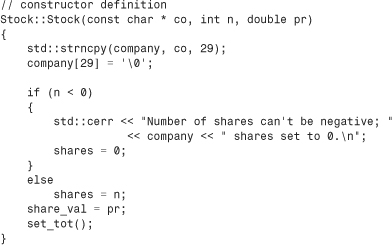
This is the same code that you used for the acquire() function earlier in this chapter. The difference is that in this case, a program automatically invokes the constructor when it declares an object.
Caution
![]()
Often those new to constructors try to use the class member names as arguments to the constructor, as in this example:
// NO!
Stock::Stock(const char * company, int shares, double share_val)
{
...
}
This is wrong. The constructor arguments don’t represent the class members; they represent values that are assigned to the class members. Thus, they must have distinct names, or you end up with confusing code like this:
shares = shares;
One common coding practice to help avoid such confusion is to use an m_ prefix to identify data member names:
class Stock
{
private:
string m_company;
int m_shares;
....
Using Constructors
C++ provides two ways to initialize an object by using a constructor. The first is to call the constructor explicitly:
Stock food = Stock("World Cabbage", 250, 1.25);
This sets the company member of the food object to the string "World Cabbage", the shares member to 250, and so on.
The second way is to call the constructor implicitly:
Stock garment("Furry Mason", 50, 2.5);
This more compact form is equivalent to the following explicit call:
Stock garment = Stock("Furry Mason", 50, 2.5));
C++ uses a class constructor whenever you create an object of that class, even when you use new for dynamic memory allocation. Here’s how to use the constructor with new:
Stock *pstock = new Stock("Electroshock Games", 18, 19.0);
This statement creates a Stock object, initializes it to the values provided by the arguments, and assigns the address of the object to the pstock pointer. In this case, the object doesn’t have a name, but you can use the pointer to manage the object. We’ll discuss pointers to objects further in Chapter 11.
Constructors are used differently from the other class methods. Normally, you use an object to invoke a method:
stock1.show(); // stock1 object invokes show() method
However, you can’t use an object to invoke a constructor because until the constructor finishes its work of making the object, there is no object. Rather than being invoked by an object, the constructor is used to create the object.
Default Constructors
A default constructor is a constructor that is used to create an object when you don’t provide explicit initialization values. That is, it’s a constructor that is used for declarations like this:
Stock stock1; // uses the default constructor
Hey, Listing 10.3 already did that! The reason this statement works is that if you fail to provide any constructors, C++ automatically supplies a default constructor. It’s an implicit version of a default constructor, and it does nothing. For the Stock class, the default constructor would look like this:
Stock::Stock() { }
The net result is that the stock1 object is created with its members uninitialized, just as
int x;
creates x without providing a value for x. The fact that the default constructor has no arguments reflects the fact that no values appear in the declaration.
A curious fact about default constructors is that the compiler provides one only if you don’t define any constructors. After you define any constructor for a class, the responsibility for providing a default constructor for that class passes from the compiler to you. If you provide a nondefault constructor, such as Stock(const char * co, int n, double pr), and don’t provide your own version of a default constructor, then a declaration like
Stock stock1; // not possible with current constructor
becomes an error. The reason for this behavior is that you might want to make it impossible to create uninitialized objects. If, however, you wish to create objects without explicit initialization, you must define your own default constructor. This is a constructor that takes no arguments. You can define a default constructor two ways. One is to provide default values for all the arguments to the existing constructor:
Stock(const char * co = "Error", int n = 0, double pr = 0.0);
The second is to use function overloading to define a second constructor, one that has no arguments:
Stock();
You can have only one default constructor, so be sure that you don’t do both. (With early versions of C++, you could use only the second method for creating a default constructor.)
Actually, you should usually initialize objects in order to ensure that all members begin with known, reasonable values. Thus, a default constructor typically provides implicit initialization for all member values. For example, this is how you might define one for the Stock class:
Stock::Stock() // default constructor
{
std::strcpy(company, "no name");
shares = 0;
share_val = 0.0;
total_val = 0.0;
}
Tip
![]()
When you design a class, you should usually provide a default constructor that implicitly initializes all class members.
After you’ve used either method (no arguments or default values for all arguments) to create the default constructor, you can declare object variables without initializing them explicitly:
Stock first; // calls default constructor implicitly
Stock first = Stock(); // calls it explicitly
Stock *prelief = new Stock; // calls it implicitly
However, you shouldn’t be misled by the implicit form of the nondefault constructor:
Stock first("Concrete Conglomerate"); // calls constructor
Stock second(); // declares a function
Stock third; // calls default constructor
The first declaration here calls the nondefault constructor—that is, the one that takes arguments. The second declaration states that second() is a function that returns a Stock object. When you implicitly call the default constructor, you don’t use parentheses.
Destructors
When you use a constructor to create an object, the program undertakes the responsibility of tracking that object until it expires. At that time, the program automatically calls a special member function bearing the formidable title destructor. The destructor should clean up any debris, so it actually serves a useful purpose. For example, if your constructor uses new to allocate memory, the destructor should use delete to free that memory. The Stock constructor doesn’t do anything fancy like using new, so the Stock class destructor doesn’t really have any tasks to perform. In such a case, you can simply let the compiler generate an implicit, do-nothing destructor, which is exactly what the first version of the Stock class does. On the other hand, it’s certainly worth looking into how to declare and define destructors, so let’s provide one for the Stock class.
Like a constructor, a destructor has a special name: It is formed from the class name preceded by a tilde (~). Thus, the destructor for the Stock class is called ~Stock(). Also, like a constructor, a destructor can have no return value and has no declared type. Unlike a constructor, a destructor must have no arguments. Thus, the prototype for a Stock destructor must be this:
~Stock();
Because a Stock destructor has no vital duties, you can code it as a do-nothing function:
Stock::~Stock()
{
}
However, just so that you can see when the destructor is called, you can code it this way:
Stock::~Stock() // class destructor
{
cout << "Bye, " << company << "!
";
}
When should a destructor be called? The compiler handles this decision; normally your code shouldn’t explicitly call a destructor. (See the section “Looking Again at Placement new” in Chapter 12 for an exception.) If you create a static storage class object, its destructor is called automatically when the program terminates. If you create an automatic storage class object, as the examples have been doing, its destructor is called automatically when the program exits the block of code in which the object is defined. If the object is created by using new, it resides in heap memory, or the free store, and its destructor is called automatically when you use delete to free the memory. Finally, a program can create temporary objects to carry out certain operations; in that case, the program automatically calls the destructor for the object when it has finished using it.
Because a destructor is called automatically when a class object expires, there ought to be a destructor. If you don’t provide one, the compiler implicitly declares a default constructor and, if it detects code that leads to the destruction of an object, it provides a definition for the destructor.
Improving the Stock Class
At this point you need to incorporate the constructors and the destructor into the class and method definitions. This time you should follow the usual C++ practice and organize the program into separate files. You can place the class declaration in a header file called stock1.h. (This name suggests the possibility of further revisions.) The class methods go into a file called stock1.cpp. In general, the header file containing the class declaration and the source code file containing the methods definitions should have the same base name so that you can keep track of which files belong together. Using separate files for the class declaration and the member functions separates the abstract definition of the interface (the class declaration) from the details of implementation (the member function definitions). You could, for example, distribute the class declaration as a text header file but distribute the function definitions as compiled code. Finally, you place the program using these resources in a third file, which you can call usestok1.cpp.
The Header File
Listing 10.4 shows the header file for the stock program. It adds prototypes for the constructor and destructor functions to the original class declaration. Also, it dispenses with the acquire() function, which is no longer necessary now that the class has constructors. The file also uses the #ifndef technique described in Chapter 9 to protect against multiple inclusion of this file.
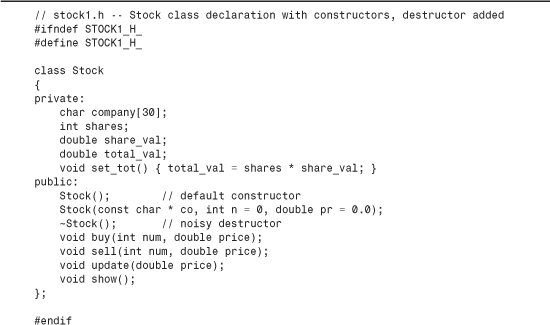
The Implementation File
Listing 10.5 provides the method definitions for the stock program. It includes the stock1.h file in order to provide the class declaration. (Recall that enclosing the filename in double quotation marks instead of in brackets causes the compiler to search for it at the same location where your source files are located.) Also, Listing 10.5 includes the iostream header file to provide I/O support and the cstring header file to support strcpy() and strncpy(). The listing also provides using declarations and qualified names (such as std::string) to provide access to various declarations in the header files. This file adds the constructor and destructor method definitions to the prior methods. To help you see when these methods are called, they each display a message. This is not a usual feature of constructors and destructors, but it can help you better visualize how classes use them.
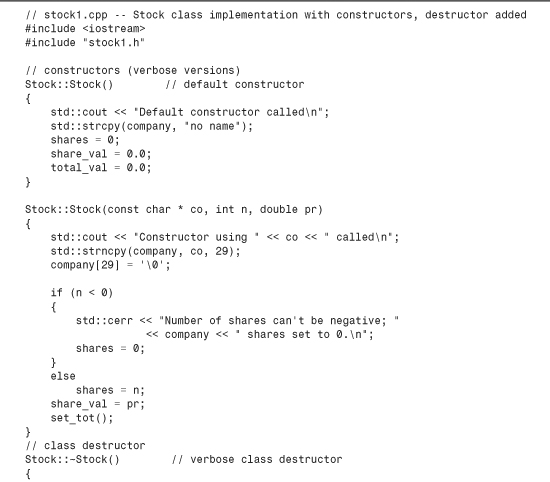

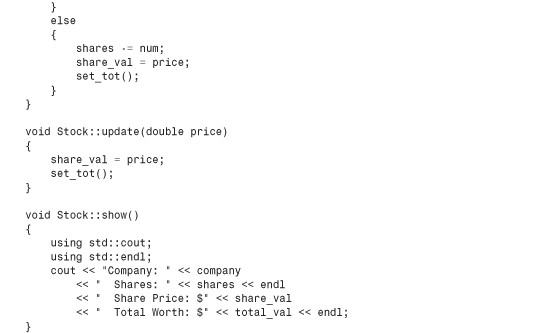
A Client File
Listing 10.6 provides a short program for testing the new methods in the stock program. Because it simply uses the Stock class, this listing is a client of the Stock class. Like stock1.cpp, it includes the stock1.h file to provide the class declaration. The program demonstrates constructors and destructors. It also uses the same formatting commands invoked by Listing 10.3. To compile the complete program, you use the techniques for multifile programs described in Chapters 1, “Getting Started,” and 8.
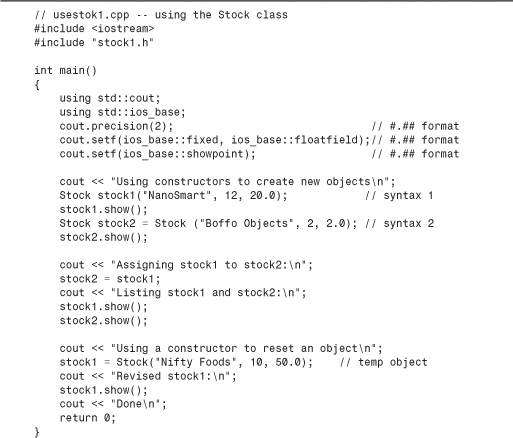
Compiling the program represented by Listings 10.4, 10.5, and 10.6 produces an executable program. Here’s one compiler’s output from the executable program:
Using constructors to create new objects
Constructor using NanoSmart called
Company: NanoSmart Shares: 12
Share Price: $20.00 Total Worth: $240.00
Constructor using Boffo Objects called
Company: Boffo Objects Shares: 2
Share Price: $2.00 Total Worth: $4.00
Assigning stock1 to stock2:
Listing stock1 and stock2:
Company: NanoSmart Shares: 12
Share Price: $20.00 Total Worth: $240.00
Company: NanoSmart Shares: 12
Share Price: $20.00 Total Worth: $240.00
Using a constructor to reset an object
Constructor using Nifty Foods called
Bye, Nifty Foods!
Revised stock1:
Company: Nifty Foods Shares: 10
Share Price: $50.00 Total Worth: $500.00
Done
Bye, NanoSmart!
Bye, Nifty Foods!
Some compilers may produce a program with the following initial output, which has one additional line:
Using constructors to create new objects
Constructor using NanoSmart called
Company: NanoSmart Shares: 12
Share Price: $20.00 Total Worth: $240.00
Constructor using Boffo Objects called
Bye, Boffo Objects! ←additional line
Company: Boffo Objects Shares: 2
Share Price: $2.00 Total Worth: $4.00
...
The “Program Notes” section explain the "Bye, Boffo Objects!" line of this output.
Program Notes
In Listing 10.6, the statement
Stock stock1("NanoSmart", 12, 20.0);
creates a Stock object called stock1 and initializes its data members to the indicated values:
Constructor using NanoSmart called
Company: NanoSmart Shares: 12
The statement
Stock stock2 = Stock ("Boffo Objects", 2, 2.0);
uses another syntax to create and initialize an object called stock2. The C++ Standard gives a compiler a couple ways to execute this second syntax. One is to make it behave exactly like the first syntax:
Constructor using Boffo Objects called
Company: Boffo Objects Shares: 2
The second way is to allow the call to the constructor to create a temporary object that is then copied to stock2. Then the temporary object is discarded. If the compiler uses this option, the destructor is called for the temporary object, producing this output instead:
Constructor using Boffo Objects called
Bye, Boffo Objects!
Company: Boffo Objects Shares: 2
The compiler that produced this output disposed of the temporary object immediately, but it’s possible that a compiler might wait longer, in which case the destructor message would be displayed later.
The statement
stock2 = stock1; // object assignment
illustrates that you can assign one object to another of the same type. As with structure assignment, class object assignment, by default, copies the members of one object to the other. In this case, the original contents of stock2 are overwritten.
Remember
![]()
When you assign one object to another of the same class, by default C++ copies the contents of each data member of the source object to the corresponding data member of the target object.
You can use the constructor for more than initializing a new object. For example, the program has this statement in main():
stock1 = Stock("Nifty Foods", 10, 50.0);
The stock1 object already exists. Therefore, instead of initializing stock1, this statement assigns new values to the object. It does so by having the constructor create a new, temporary object and then copying the contents of the new object to stock1. Then the program disposes of the temporary object, invoking the destructor as it does so, as illustrated by the following annotated output:

Some compilers might dispose of the temporary object later, delaying the destructor call.
Finally, at the end, the program displays this:
Done
Bye, NanoSmart!
Bye, Nifty Foods!
When the main() function terminates, its local variables (stock1 and stock2) pass from your plane of existence. Because such automatic variables go on the stack, the last object created is the first deleted, and the first created is the last deleted. (Recall that "NanoSmart" was originally in stock1 but was later transferred to stock2, and stock1 was reset to "Nifty Foods".)
The output points out that there is a fundamental difference between the following two statements:
Stock stock2 = Stock ("Boffo Objects", 2, 2.0);
stock1 = Stock("Nifty Foods", 10, 50.0); // temporary object
The first of these statements invokes initialization; it creates an object with the indicated value, and it may or may not create a temporary object. The second statement invokes assignment. Using a constructor in an assignment statement in this fashion always causes the creation of a temporary object before assignment occurs.
Tip
![]()
If you can set object values either through initialization or by assignment, choose initialization. It is usually more efficient.
const Member Functions
Consider the following code snippet:
const Stock land = Stock("Kludgehorn Properties");
land.show();
With current C++, the compiler should object to the second line. Why? Because the code for show() fails to guarantee that it won’t modify the invoking object, which, because it is const, should not be altered. You’ve solved this kind of problem before by declaring a function’s argument to be a const reference or a pointer to const. But here you have a syntax problem: The show() method doesn’t have any arguments. Instead, the object it uses is provided implicitly by the method invocation. What you need is a new syntax, one that says a function promises not to modify the invoking object. The C++ solution is to place the const keyword after the function parentheses. That is, the show() declaration should look like this:
void show() const; // promises not to change invoking object
Similarly, the beginning of the function definition should look like this:
void stock::show() const // promises not to change invoking object
Class functions declared and defined this way are called const member functions. Just as you should use const references and pointers as formal function arguments whenever appropriate, you should make class methods const whenever they don’t modify the invoking object. We’ll follow this rule from here on out.
Constructors and Destructors in Review
Now that we’ve gone through a few examples of constructors and destructors, you might want to pause and assimilate what has passed. To help you, here is a summary of these methods.
A constructor is a special class member function that’s called whenever an object of that class is created. A class constructor has the same name as its class, but, through the miracle of function overloading, you can have more than one constructor with the same name, provided that each has its own signature, or argument list. Also, a constructor has no declared type. Usually, a constructor is used to initialize members of a class object. Your initialization should match the constructor’s argument list. For example, suppose the Bozo class has the following prototype for a class constructor:
Bozo(const char * fname, const char * lname); // constructor prototype
In this case, you would use it to initialize new objects as follows:
Bozo bozetta = bozo("Bozetta", "Biggens"); // primary form
Bozo fufu("Fufu", "O'Dweeb"); // short form
Bozo *pc = new Bozo("Popo", "Le Peu"); // dynamic object
If a constructor has just one argument, that constructor is invoked if you initialize an object to a value that has the same type as the constructor argument. For example, suppose you have this constructor prototype:
Bozo(int age);
Then you can use any of the following forms to initialize an object:
Bozo dribble = bozo(44); // primary form
Bozo roon(66); // secondary form
Bozo tubby = 32; // special form for one-argument constructors
Actually, the third example is a new point, not a review point, but it seemed like a nice time to tell you about it. Chapter 11 mentions a way to turn off this feature.
Remember
![]()
A constructor that you can use with a single argument allows you to use assignment syntax to initialize an object to a value:
Classname object = value;
A default constructor has no arguments, and it is used if you create an object without explicitly initializing it. If you fail to provide any constructors, the compiler defines a default constructor for you. Otherwise, you have to supply your own default constructor. It can have no arguments or else it must have default values for all arguments:
Bozo(); // default constructor prototype
Bistro(const char * s = "Chez Zero"); // default for Bistro class
The program uses the default constructor for uninitialized objects:
Bozo bubi; // use default
Bozo *pb = new Bozo; // use default
Just as a program invokes a constructor when an object is created, it invokes a destructor when an object is destroyed. You can have only one destructor per class. It has no return type (not even void), it has no arguments, and its name is the class name preceded by a tilde. For example, the Bozo class destructor has the following prototype:
~Bozo(); // class destructor
Class destructors that use delete become necessary when class constructors use new.
Knowing Your Objects: The this Pointer
You can do still more with the Stock class. So far each class member function has dealt with but a single object: the object that invokes it. Sometimes, however, a method might need to deal with two objects, and doing so may involve a curious C++ pointer called this. Let’s look at how the need for this can unfold.
Although the Stock class declaration displays data, it’s deficient in analytic power. For example, by looking at the show() output, you can tell which of your holdings has the greatest value, but the program can’t tell because it can’t access total_val directly. The most direct way of letting a program know about stored data is to provide methods to return values. Typically, you use inline code for this, as in the following example:
class Stock
{
private:
...
double total_val;
...
public:
double total() const { return total_val; }
...
};
This definition, in effect, makes total_val read-only memory as far as a direct program access is concerned. That is, you can use the total_val() method to obtain the value, but the class doesn’t provide a method for specifically resetting the value of total_val. (Other methods, such as buy(), sell(), and update(), do modify total_val as a by-product of resetting the shares and share_val members.)
By adding this function to the class declaration, you can let a program investigate a series of stocks to find the one with the greatest value. However, you can take a different approach, one that helps you learn about the this pointer. The approach is to define a member function that looks at two Stock objects and returns a reference to the larger of the two. Attempting to implement this approach raises some interesting questions, which we’ll look into now.
First, how do you provide the member function with two objects to compare? Suppose, for example, that you decide to name the method topval(). Then, the function call stock1.topval() accesses the data of the stock1 object, whereas the message stock2.topval() accesses the data of the stock2 object. If you want the method to compare two objects, you have to pass the second object as an argument. For efficiency, you can pass the argument by reference. That is, you can have the topval() method use a type const Stock & argument.
Second, how do you communicate the method’s answer back to the calling program? The most direct way is to have the method return a reference to the object that has the larger total value. Thus, the comparison method should have the following prototype:
const Stock & topval(const Stock & s) const;
This function accesses one object implicitly and one object explicitly, and it returns a reference to one of those two objects. The const in parentheses states that the function won’t modify the explicitly accessed object, and the const that follows the parentheses states that the function won’t modify the implicitly accessed object. Because the function returns a reference to one of the two const objects, the return type also has to be a const reference.
Suppose, then, that you want to compare the Stock objects stock1 and stock2 and assign the one with the greater total value to the object top. You can use either of the following statements to do so:
top = stock1.topval(stock2);
top = stock2.topval(stock1);
The first form accesses stock1 implicitly and stock2 explicitly, whereas the second accesses stock1 explicitly and stock2 implicitly. (See Figure 10.3.) Either way, the method compares the two objects and returns a reference to the one with the higher total value.
Figure 10.3. Accessing two objects by using a member function.
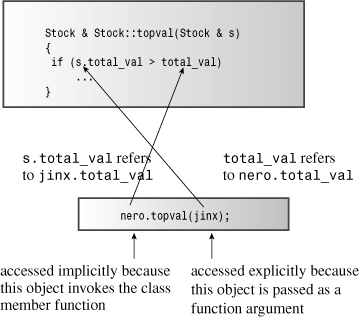
Actually, this notation is a bit confusing. It would be clearer if you could somehow use the relational operator > to compare the two objects. You can do so with operator overloading, which Chapter 11 discusses.
Meanwhile, there’s still the implementation of topval() to attend to. It raises a slight problem. Here’s a partial implementation that highlights the problem:
const Stock & Stock::topval(const Stock & s) const
{
if (s.total_val > total_val)
return s; // argument object
else
return ?????; // invoking object
}
Here s.total_val is the total value for the object passed as an argument, and total_val is the total value for the object to which the message is sent. If s.total_val is greater than total_val, the function returns s. Otherwise, it returns the object used to evoke the method. (In OOP talk, that is the object to which the topval message is sent.) Here’s the problem: What do you call that object? If you make the call stock1.topval(stock2), then s is a reference for stock2 (that is, an alias for stock2), but there is no alias for stock1.
The C++ solution to this problem is to use a special pointer called this. The this pointer points to the object used to invoke a member function. (Basically, this is passed as a hidden argument to the method.) Thus, the function call stock1.topval(stock2) sets this to the address of the stock1 object and makes that pointer available to the topval() method. Similarly, the function call stock2.topval(stock1) sets this to the address of the stock2 object. In general, all class methods have a this pointer set to the address of the object that invokes the method. Indeed, total_val in topval() is just shorthand notation for this->total_val. (Recall from Chapter 4, “Compound Types,” that you use the -> operator to access structure members via a pointer. The same is true for class members.) (See Figure 10.4.)
Figure 10.4. this points to the invoking object.
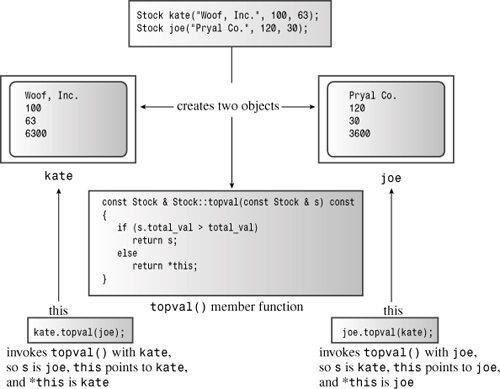
What you want to return, however, is not this because this is the address of the object. You want to return the object itself, and that is symbolized by *this. (Recall that applying the dereferencing operator * to a pointer yields the value to which the pointer points.) Now you can complete the method definition by using *this as an alias for the invoking object:

The fact that the return type is a reference means that the returned object is the invoking object itself rather than a copy passed by the return mechanism. Listing 10.7 shows the new header file.
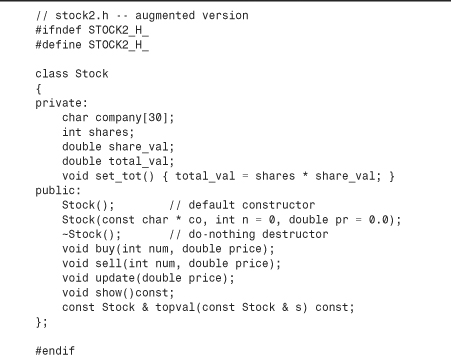
Listing 10.8 presents the revised class methods file. It includes the new topval() method. Also, now that you’ve seen how the constructors and destructor work, Listing 10.8 replaces them with silent versions.
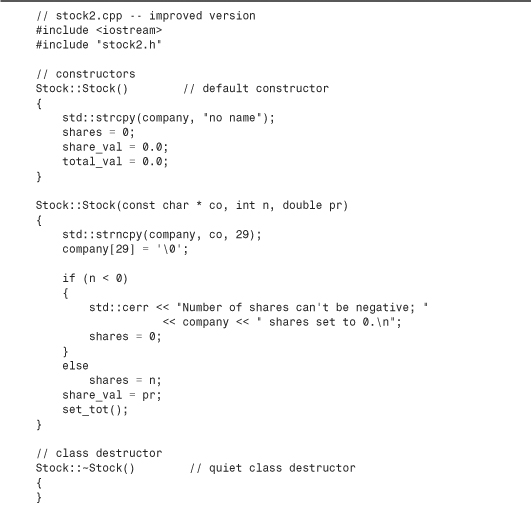
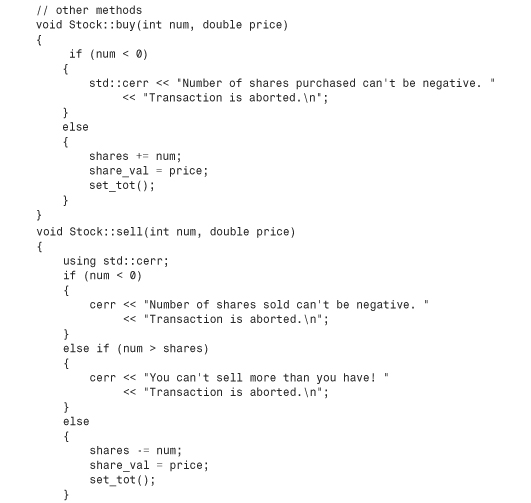

Of course, you want to see if the this pointer works, and a natural place to use the new method is in a program with an array of objects, which leads us to the next topic.
An Array of Objects
Often, as with the Stock examples, you want to create several objects of the same class. You can create separate object variables, as the examples have done so far in this chapter, but it might make more sense to create an array of objects. That might sound like a major leap into the unknown, but, in fact, you declare an array of objects the same way you declare an array of any of the standard types:
Stock mystuff[4]; // creates an array of 4 Stock objects
Recall that a program always calls the default class constructor when it creates class objects that aren’t explicitly initialized. This declaration requires either that the class explicitly define no constructors at all, in which case the implicit do-nothing default constructor is used, or, as in this case, that an explicit default constructor be defined. Each element—mystuff[0], mystuff[1], and so on—is a Stock object and thus can be used with the Stock methods:
mystuff[0].update(); // apply update() to 1st element
mystuff[3].show(); // apply show() to 4th element
Stock tops = mystuff[2].topval(mystuff[1]);
// compare 3rd and 2nd elements
You can use a constructor to initialize the array elements. In that case, you have to call the constructor for each individual element:
const int STKS = 4;
Stock stocks[STKS] = {
Stock("NanoSmart", 12.5, 20),
Stock("Boffo Objects", 200, 2.0),
Stock("Monolithic Obelisks", 130, 3.25),
Stock("Fleep Enterprises", 60, 6.5)
};
Here the code uses the standard form for initializing an array: a comma-separated list of values enclosed in braces. In this case, a call to the constructor method represents each value. If the class has more than one constructor, you can use different constructors for different elements:
const int STKS = 10;
Stock stocks[STKS] = {
Stock("NanoSmart", 12.5, 20),
Stock(),
Stock("Monolithic Obelisks", 130, 3.25),
};
This initializes stocks[0] and stocks[2] using the Stock(const char * co, int n, double pr) constructor and stocks[1] using the Stock() constructor. Because this declaration only partially initializes the array, the remaining seven members are initialized using the default constructor.
The scheme for initializing an array of objects still initially uses the default constructor to create the array elements. Then, the constructors in the braces create temporary objects whose contents are copied to the vector. Thus, a class must have a default constructor if you want to create arrays of class objects.
Listing 10.9 applies these principles to a short program that initializes four array elements, displays their contents, and tests the elements to find the one with the highest total value. Because topval() examines just two objects at a time, the program uses a for loop to examine the whole array. This listing uses the Listing 10.7 header file and the Listing 10.8 methods file.

Here is the output from the program in Listing 10.9:
Stock holdings:
Company: NanoSmart Shares: 12
Share Price: $20.00 Total Worth: $240.00
Company: Boffo Objects Shares: 200
Share Price: $2.00 Total Worth: $400.00
Company: Monolithic Obelisks Shares: 130
Share Price: $3.25 Total Worth: $422.50
Company: Fleep Enterprises Shares: 60
Share Price: $6.50 Total Worth: $390.00
Most valuable holding:
Company: Monolithic Obelisks Shares: 130
Share Price: $3.25 Total Worth: $422.50
One thing to note about Listing 10.9 is that most of the work goes into designing the class. When that’s done, writing the program itself is rather simple.
Incidentally, knowing about the this pointer makes it easier to see how C++ works under the skin. For example, the C++ front-end cfront converts C++ programs to C programs. To handle method definitions, all it has to do is convert a C++ method definition like
void Stock::show() const
{
cout << "Company: " << company
<< " Shares: " << shares << '
'
<< " Share Price: $" << share_val
<< " Total Worth: $" << total_val << '
';
}
to the following C-style definition:
void show(const Stock * this)
{
cout << "Company: " << this->company
<< " Shares: " << this->shares << '
'
<< " Share Price: $" << this->share_val
<< " Total Worth: $" << this->total_val << '
';
}
That is, it converts a Stock:: qualifier to a function argument that is a pointer to Stock and then uses the pointer to access class members.
Similarly, the front end converts function calls like
top.show();
to this:
show(&top);
In this fashion, the this pointer is assigned the address of the invoking object. (The actual details might be more involved.)
The Interface and Implementation Revisited
By using a character array with 30 elements, the Stock class limits the length of a name that it can store to 29 characters. For example, the statement
Stock firm ("Dunkelmeister, Dostoyevsky, and Delderfield Construction", 8, 2.5);
results in the truncated string "Dunkelmeister, Dostoyevsky, a" being stored in the firm object.
You can remove the length restriction by changing the class implementation. One approach is to increase the array size, but that leads to space often being wasted. Another approach is to use a string object instead of an array, relying on the automatic sizing of string objects. This entails three changes.
The first change is to add string class support by including the string header file in stock2.h. Because stock2.cpp includes stock2.h, the string class gets supported in stock2.cpp, also.
The second change is to modify the private section of the class definition in stock2.h. You change
class Stock
{
private:
char company[30];
...
to the following:
class Stock
{
private:
std::string company;
...
The third change is to modify the constructor definition in stock2.cpp. You change
Stock::Stock(const char * co, int n, double pr)
{
std::strncpy(company, co, 29);
company[29] = '�';
...
to this:
Stock::Stock(const char * co, int n, double pr)
{
company = co; // assign C-style string to string object
...
These changes are examples of changing the implementation. You’ve made changes in the private section of the class declaration, and you’ve made changes in the implementation file. However, you haven’t changed the public section of the class. Someone using the class still has the same list of methods from which to choose. Thus, the class interface is unchanged. True, a Stock object can store all of "Dunkelmeister, Dostoyevsky, and Delderfield Construction", but the code remains unchanged:
Stock firm ("Dunkelmeister, Dostoyevsky, and Delderfield Construction", 8, 2.5);
You could also add a new constructor:
Stock(const std::string & co, int n, double pr);
This would be an interface change. The list of available methods would be changed, and a programmer using the class would have new options. For example, a program could use this:
string business;
getline(cout, business);
Stock mine(business, 10, 120.5); // use new constructor
In short, changes in the private section of a class and in the implementation file are implementation changes; changes in the public section of a class are interface changes. Implementation changes alter the internal workings of a class, and interface changes alter the coding choices available to someone using the class.
Perhaps you’re wondering about using a class object as a member of another class. It’s okay to use objects as class members; after all, one of the goals of classes is to make these user-defined types as similar as possible to built-in types. A class constructor automatically sees to it that the constructors for any object members get called. There is a language feature called the member initialization list that can improve the efficiency of constructor design; Chapter 14, “Reusing Code in C++,” pursues that topic further.
Class Scope
Chapter 9 discusses global (or file) scope and local (or block) scope. Recall that you can use a variable with global scope anywhere in the file that contains its definition, whereas a variable with local scope is local to the block that contains its definition. Function names, too, can have global scope, but they never have local scope. C++ classes introduce a new kind of scope: class scope.
Class scope applies to names defined in a class, such as the names of class data members and class member functions. Items that have class scope are known within the class but not outside the class. Thus, you can use the same class member names in different classes without conflict. For example, the shares member of the Stock class is distinct from the shares member of a JobRide class. Also, class scope means you can’t directly access members of a class from the outside world. This is true even for public function members. That is, to invoke a public member function, you have to use an object:
Stock sleeper("Exclusive Ore", 100, 0.25); // create object
sleeper.show(); // use object to invoke a member function
show(); // invalid -- can't call method directly
Similarly, you have to use the scope-resolution operator when you define member functions:

In short, within a class declaration or a member function definition you can use an unadorned member name (the unqualified name), as when sell() calls the set_tot() member function. A constructor name is recognized when it is called because its name is the same as the class name. Otherwise, you must use the direct membership operator (.), the indirect membership operator (->), or the scope-resolution operator (::), depending on the context, when you use a class member name. The following code fragment illustrates how identifiers with class scope can be accessed:
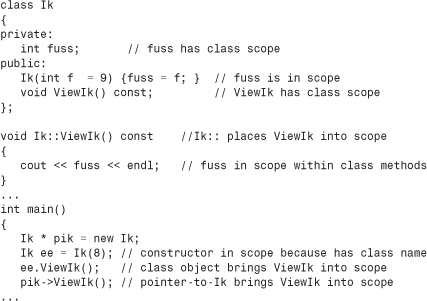
Class Scope Constants
Sometimes it would be nice to have symbolic constants with class scope. For example, the Stock class declaration uses the literal 30 to specify the array size for company. Also, because the constant is the same for all objects, it would be nice to create a single constant shared by all objects. You might think the following would be a solution:

But this won’t work because declaring a class describes what an object looks like but doesn’t create an object. Hence, until you create an object, there’s no place to store a value. There are, however, a couple ways to achieve essentially the same desired effect.
First, you can declare an enumeration within a class. An enumeration given in a class declaration has class scope, so you can use enumerations to provide class scope symbolic names for integer constants. That is, you can start off the Stock declaration this way:
class Stock
{
private:
enum {Len = 30}; // class-specific constant
char company[Len];
...
Note that declaring an enumeration in this fashion does not create a class data member. That is, each individual object does not carry an enumeration in it. Rather, Len is just a symbolic name that the compiler replaces with 30 when it encounters it in code in class scope.
Because this uses the enumeration merely to create a symbolic constant, with no intent of creating variables of the enumeration type, you needn’t provide an enumeration tag. Incidentally, for many implementations, the ios_base class does something similar in its public section; that’s the source of identifiers such as ios_base::fixed. Here fixed is typically an enumerator defined in the ios_base class.
More recently, C++ has introduced a second way of defining a constant within a class—using the keyword static:
class Stock
{
private:
static const int Len = 30; // declare a constant! WORKS
char company[Len];
...
This creates a single constant called Len that is stored with other static variables rather than in an object. Thus, there is only one Len constant shared by all Stock objects. Chapter 12, “Classes and Dynamic Memory Allocation,” looks further into static class members. You can use this technique only for declaring static constants with integral and enumeration values. You can’t store a double constant this way.
Abstract Data Types
The Stock class is pretty specific. Often, however, programmers define classes to represent more general concepts. For example, using classes is a good way to implement what computer scientists describe as abstract data types (ADTs). As the name suggests, an ADT describes a data type in a general fashion, without bringing in language or implementation details. Consider, for example, the stack. By using the stack, you can store data so that data is always added to or deleted from the top of the stack. For example, C++ programs use a stack to manage automatic variables. As new automatic variables are generated, they are added to the top of the stack. When they expire, they are removed from the stack.
Let’s look at the properties of a stack in a general, abstract way. First, a stack holds several items. (That property makes it a container, an even more general abstraction.) Next, a stack is characterized by the operations you can perform on it:
• You can create an empty stack.
• You can add an item to the top of a stack (that is, you can push an item).
• You can remove an item from the top (that is, you can pop an item).
• You can check whether the stack is full.
• You can check whether the stack is empty.
You can match this description with a class declaration in which the public member functions provide an interface that represents the stack operations. The private data members take care of storing the stack data. The class concept is a nice match to the ADT approach.
The private section has to commit itself to how to hold the data. For example, you can use an ordinary array, a dynamically allocated array, or some more advanced data structure, such as a linked list. However, the public interface should hide the exact representation. Instead, it should be expressed in general terms, such as creating a stack, pushing an item, and so on. Listing 10.10 shows one approach. It assumes that the bool type has been implemented. If it hasn’t been implemented on your system, you can use int, 0, and 1 rather than bool, false, and true.
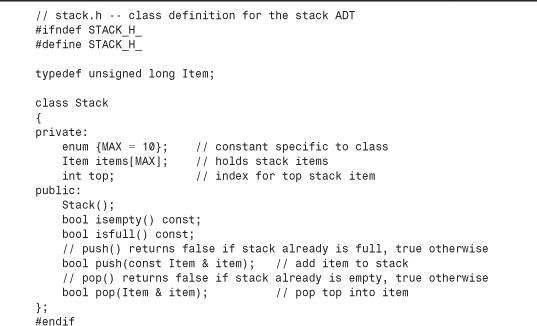
Compatibility Note
![]()
If your system hasn’t implemented the bool type, you can use int, 0, and 1 rather than bool, false, and true. Alternatively, your system might support an earlier, nonstandard form, such as boolean or Boolean.
In the example in Listing 10.10, the private section shows that the stack is implemented by using an array, but the public section doesn’t reveal that fact. Thus, you can replace the array with, say, a dynamic array without changing the class interface. This means changing the stack implementation doesn’t require that you recode programs that use the stack. You just recompile the stack code and link it with existing program code.
The interface is redundant in that pop() and push() return information about the stack status (full or empty) instead of being type void. This provides the programmer with a couple options as to how to handle exceeding the stack limit or emptying the stack. He or she can use isempty() and isfull() to check before attempting to modify the stack, or else use the return value of push() and pop() to determine whether the operation is successful.
Rather than define the stack in terms of some particular type, the class describes it in terms of a general Item type. In this case, the header file uses typedef to make Item the same as unsigned long. If you want, say, a stack of doubles or of a structure type, you can change the typedef and leave the class declaration and method definitions unaltered. Class templates (see Chapter 14) provide a more powerful method for isolating from the class design the type of data stored.
Next, you need to implement the class methods. Listing 10.11 shows one possibility.

The default constructor guarantees that all stacks are created empty. The code for pop() and push() guarantees that the top of the stack is managed properly. Guarantees like this are one of the things that make OOP reliable. Suppose that, instead, you create a separate array to represent the stack and an independent variable to represent the index of the top. In that case, it is your responsibility to get the code right each time you create a new stack. Without the protection that private data offers, there’s always the possibility of making some program blunder that alters data unintentionally.
Let’s test this stack. Listing 10.12 models the life of a clerk who processes purchase orders from the top of his in-basket, using the LIFO (last-in, first-out) approach of a stack.
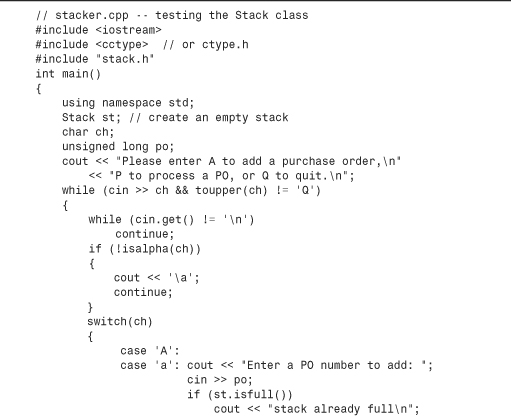
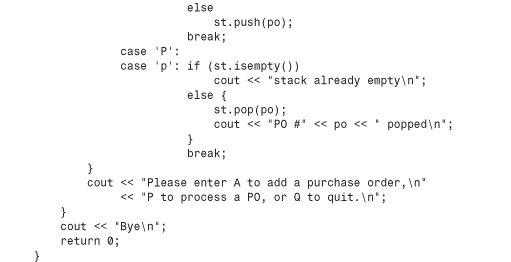
The little while loop in Listing 10.12 that gets rid of the rest of the line isn’t absolutely necessary at this point, but it will come in handy in a modification of this program in Chapter 14. Here’s a sample run:
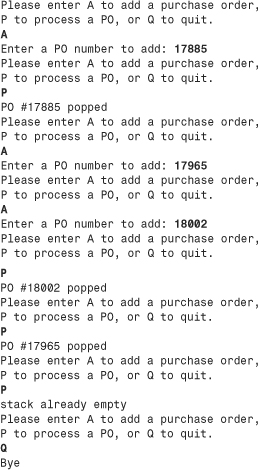
Real-World Note: Minimizing Class Size with Selective Data Typing
![]()
When designing classes, you need to give careful thought to the data types you use for class members. Imprudent use of nonstandard or platform-dependent data types inflates the size of your classes, thereby increasing the memory footprint, or working set, of your programs. This is both inefficient and considered bad form.
A classic example that demonstrates this point involves using a nonstandard BOOL typedef instead of the standard bool data type. Consider these simple classes:
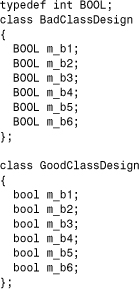
Unlike bool, which usually occupies only 1 byte on most platforms, each BOOL typically occupies 4 bytes. If the intent for the class members is to manage a true Boolean value of true or false, only 1 byte is actually required. For the typical Intel platform machine, the class BadClassDesign occupies 24 bytes, and the class ClassGoodDesign uses only 6 bytes. That’s a 400% savings!
You should always strive to use appropriate data types that minimize the amount of memory your program requires.
Summary
OOP emphasizes how a program represents data. The first step toward solving a programming problem by using the OOP approach is to describe the data in terms of its interface with the program, specifying how the data is used. Next, you need to design a class that implements the interface. Typically, private data members store the information, whereas public member functions, also called methods, provide the only access to the data. The class combines data and methods into one unit, and the private aspect accomplishes data hiding.
Usually, you separate a class declaration into two parts, typically kept in separate files. The class declaration proper goes into a header file, with the methods represented by function prototypes. The source code that defines the member functions goes into a methods file. This approach separates the description of the interface from the details of the implementation. In principle, you need to know only the public class interface to use the class. Of course, you can look at the implementation (unless it’s been supplied to you in compiled form only), but your program shouldn’t rely on details of the implementation, such as knowing that a particular value is stored as an int. As long as a program and a class communicate only through methods defining the interface, you are free to improve either part separately without worrying about unforeseen interactions.
A class is a user-defined type, and an object is an instance of a class. This means an object is a variable of that type or the equivalent of a variable, such as memory allocated by new according to the class specification. C++ tries to make user-defined types as similar as possible to standard types, so you can declare objects, pointers to objects, and arrays of objects. You can pass objects as arguments, return them as function return values, and assign one object to another of the same type. If you provide a constructor method, you can initialize objects when they are created. If you provide a destructor method, the program executes that method when the object expires.
Each object holds its own copies of the data portion of a class declaration, but they share the class methods. If mr_object is the name of a particular object and try_me() is a member function, you invoke the member function by using the dot membership operator: mr_object.try_me(). OOP terminology describes this function call as sending a try_me message to the mr_object object. Any reference to class data members in the try_me() method then applies to the data members of the mr_object object. Similarly, the function call i_object.try_me() accesses the data members of the i_object object.
If you want a member function to act on more than one object, you can pass additional objects to the method as arguments. If a method needs to refer explicitly to the object that evoked it, it can use the this pointer. The this pointer is set to the address of the evoking object, so *this is an alias for the object itself.
Classes are well matched to describing ADTs. The public member function interface provides the services described by an ADT, and the class’s private section and the code for the class methods provide an implementation that is hidden from clients of the class.
Review Questions
1. What is a class?
2. How does a class accomplish abstraction, encapsulation, and data hiding?
3. What is the relationship between an object and a class?
4. In what way, aside from being functions, are class function members different from class data members?
5. Define a class to represent a bank account. Data members should include the depositor’s name, the account number (use a string), and the balance. Member functions should allow the following:
• Creating an object and initializing it.
• Displaying the depositor’s name, account number, and balance
• Depositing an amount of money given by an argument
• Withdrawing an amount of money given by an argument
Just show the class declaration, not the method implementations. (Programming Exercise 1 provides you with an opportunity to write the implementation.)
6. When are class constructors called? When are class destructors called?
7. Provide code for a constructor for the bank account class from Review Question 5.
8. What is a default constructor? What is the advantage of having one?
9. Modify the Stock class (the version in stock2.h) so that it has member functions that return the values of the individual data members. Note: A member that returns the company name should not provide a weapon for altering the array. That is, it can’t simply return a char *. It could return a const pointer, or it could return a pointer to a copy of the array, manufactured by using new.
10. What are this and *this?
Programming Exercises
1. Provide method definitions for the class described in Review Question 5 and write a short program that illustrates all the features.
2. Here is a rather simple class definition:
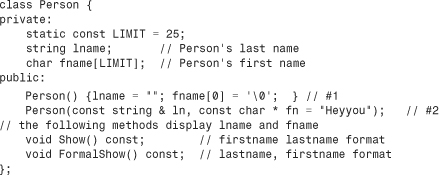
Write a program that completes the implementation by providing code for the undefined methods. The program in which you use the class should also use the three possible constructor calls (no arguments, one argument, and two arguments) and the two display methods. Here’s an example that uses the constructors and methods:

3. Do Programming Exercise 1 from Chapter 9, but replace the code shown there with an appropriate golf class declaration. Replace setgolf(golf &, const char *, int) with a constructor with the appropriate argument for providing initial values. Retain the interactive version of setgolf(), but implement it by using the constructor. (For example, for the code for setgolf(), obtain the data, pass the data to the constructor to create a temporary object, and assign the temporary object to the invoking object, which is *this.)
4. Do Programming Exercise 4 from Chapter 9, but convert the Sales structure and its associated functions to a class and its methods. Replace the setSales(Sales &, double [], int) function with a constructor. Implement the interactive setSales(Sales &) method by using the constructor. Keep the class within the namespace SALES.
5. Consider the following structure declaration:
struct customer {
char fullname[35];
double payment;
};
Write a program that adds and removes customer structures from a stack, represented by a Stack class declaration. Each time a customer is removed, his or her payment should be added to a running total, and the running total should be reported. Note: You should be able to use the Stack class unaltered; just change the typedef declaration so that Item is type customer instead of unsigned long.
6. Here’s a class declaration:

Create member function definitions and a program that exercises the class.
7. A Betelgeusean plorg has these properties:
Data
A plorg has a name with no more than 19 letters.
A plorg has a contentment index (CI), which is an integer.
Operations
A new plorg starts out with a name and a CI of 50.
A plorg’s CI can change.
A plorg can report its name and CI.
The default plorg has the name "Plorga".
Write a Plorg class declaration (including data members and member function prototypes) that represents a plorg. Write the function definitions for the member functions. Write a short program that demonstrates all the features of the Plorg class.
8. You can describe a simple list as follows:
• The simple list can hold zero or more items of some particular type.
• You can create an empty list.
• You can add items to the list.
• You can determine whether the list is empty.
• You can determine whether the list is full.
• You can visit each item in the list and perform some action on it.
As you can see, this list really is simple; it doesn’t allow insertion or deletion, for example.
Design a List class to represent this abstract type. You should provide a list.h header file with the class declaration and a list.cpp file with the class method implementations. You should also create a short program that utilizes your design.
The main reason for keeping the list specification simple is to simplify this programming exercise. You can implement the list as an array or, if you’re familiar with the data type, as a linked list. But the public interface should not depend on your choice. That is, the public interface should not have array indices, pointers to nodes, and so on. It should be expressed in the general concepts of creating a list, adding an item to the list, and so on. The usual way to handle visiting each item and performing an action is to use a function that takes a function pointer as an argument:
void visit(void (*pf)(Item &));
Here pf points to a function (not a member function) that takes a reference to Item argument, where Item is the type for items in the list. The visit() function applies this function to each item in the list. You can use the Stack class as a general guide.

